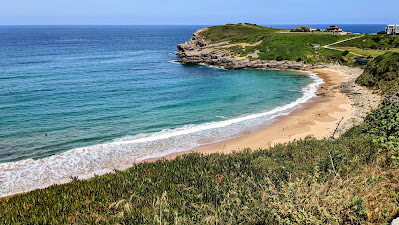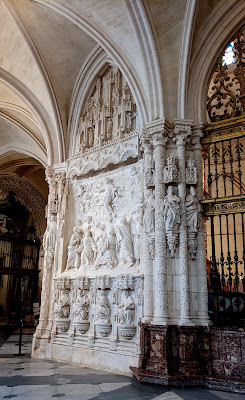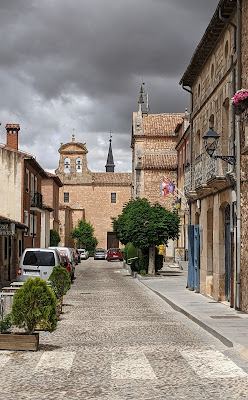After leaving sleepy San Asensio in the Rioja I headed mostly west through some hilly countryside and arrived less than 100 miles later in Burgos, in the northwestern corner of the autonomous region of Castilla y Léon. The contrast couldn't have been less stark as Burgos is a bustling city with close to 200,000 inhabitants, a major university, and three UNESCO World Heritage Sites. San Asensio didn't have any of these, but it did feature a bakery, a butcher, and a fishmonger in addition to two bars. 😁
 |
| Fountain paying homage to the pilgrims of the Camino de Santiago |
 |
| My Airbnb was in the first full house from the right, third floor, left-most door of the three on that floor |
 |
| All four photos from my first day's ride |
My four rides that I took in the immediate Burgos area once again led me into all four compass directions, just like the week before. The landscape is similar to what one finds in the Rioja, but not quite as open and far reaching in its vistas. There are more ridges that often feature wind turbines, and there is no river like the Ebro that has shaped a major valley. The absence of vineyards is immediately obvious; instead, one rides through large fields of wheat, barley, and alfalfa. There are far fewer orchards, and it seemed to me that there were fewer small towns even though I still came across a fair number of scenic places.
Burgos is a large city with its accompanying commerce, and it has been a focal point of the region for many centuries. The Camino de Santiago (which, incidentally, also leads through Logroño) was responsible for bringing pilgrims and their customs and way of thinking from France as well as Italy and other central European countries (of course, more than 1,200 years ago they weren't countries yet in today's sense). With the pilgrims came commerce, foreign wares, and novel thinking, and before long thriving cities such as Burgos became dominant forces.
Once in a while, during my rides in the Rioja and also in the Burgos area, I would cross the camino and invariably see a few modern-day pilgrims, laden with heavy backpacks and walking all or only part of the way to Santiago de Compostela in the north-west corner of the country. Quite frankly, I didn't think that it could be much fun to walk for 20 straight kilometers on a dusty trail along the N-232 national road, blisters and aching muscles slowing the "pilgrim" to a snail's pace. Undoubtedly, for some folks religious motives are still behind setting out on the many-hundred-miles-long trail, but for others it seems to be more a question of an arduous hike on par with the Pacific Crest Trail or similar—just not as scenic in many places. (Some sections of the camino are well known for their spectacular setting, but what I saw of it was less exciting for a walker.) Some peregrinos embark on their journey on a bike, and that makes more sense to me since northern Spain is vast and progress on foot is slow and arduous.
 |
| The camino and so-called modern art meet |
The other memorable ride took me to the truly ancient—that is to say, prehistoric—settlement of Atapuerca, another one of the UNESCO's declared World Heritage Sites. Quite frankly, I was less impressed by the concrete rhinoceros and replicas of huts that were used to give visitors an idea of how some of Europe's earliest humanoids lived rather than by once again the swooping hillsides and tiny villages that I crossed through. I spent a lazy hour in a small restaurant in Agės on the camino and had an interesting conversation with a man who was in the middle of a six-week hike with his 10-year-old daughter. He agreed that the walking stages between accommodations and other services can be rather long.
Having run out of suitable loop options after four days in Burgos I decided to use the car to drive about 30 miles south to the Duero river valley. I parked the car at a large supermarket on the outskirts of Aranda de Duero (secure and shaded parking and a bathroom to get changed after the ride, plus a chance to buy some supplies and ogle the seafood and olive oil selections!) and embarked on my mapped-out route. The Ribera del Duero is one of Spain's major wine regions, and I had hoped to be engulfed by vineyards once again, riding along an attractive river. But, I am sorry to report, the Duero (at least in these parts) is a muddy looking, smallish river that reminded me of the Pecos in far West Texas. The only times I saw the Duero was when the road would cross it; most of the time the asphalt stayed far away from its banks. The vineyards did not have the same healthy appearance as those in the Rioja, and they certainly weren't as well kept. Of course, I saw only a very small portion of the Ribera del Duero, but first impressions are generally lasting, if not correct. The ride was OK, but certainly not great. At least there was a nice lunch of grilled sepia and a few beers at the end in the city square.
Torrelavega is located on the river Saja just a few miles away from the Atlantic coast. A well-kept, paved bike trail leads along the river all the way to its mouth below the tourist town of Suances. It was a stunningly beautiful ride, first with views of the river's estuary and then the ocean. I climbed from the river to the cliffs that Suances is built on, and the view was simply breathtaking. Numerous sandy beaches are interspersed with rocky coves, and a few people were in the water. I later learned that Santander also has extensive sand beaches that are considered some of the best in Spain. I had always thought of the north coast as being inhospitable, with crummy weather and big storms, but that is only a small part of the picture and the price that one pays for the green mountains in the hinterland. I definitely will have to visit this part of the world again, even if riding for an old, fat dude is not always easy because of the very hilly terrain.
After having gotten my fill of going nuts over the views I finally turned back inland and rode back to the car. I had been keeping track of my time and decided to drive an extra 30 kilometers or so west to the small fishing town of San Vicente de Barquera, which had been mentioned by a friend on Facebook as being perfectly situated and a great place for seafood. I was not disappointed. After parking the car I spent a couple of hours walking around and eventually ended up in a seafront marisquería where I enjoyed grilled octopus accompanied by a couple of glasses of albariño. Man, it was paradise!
One thing that I really enjoyed about Burgos was that I was right in the middle of a lively city that wakes up when the sun draws near to the horizon. San Asensio had two bars and a cafetería, and eating out was very limited to whatever sandwiches and other bites these offered. But Burgos has a teeming tapas scene, and I never even thought of cooking anything for myself as I had in the Rioja. Tapas—or finger foods—are Spain's culinary contribution to the world's happiness. I never had the urge to sit down for a full meal; instead I'd go to two or three or even four different tapas bars and order one or two small portions, accompanied by a glass of wine. Each tapa will cost between about €1.50 to €2.50 (sometimes a little more if it is something exotic), and a small glass of wine will set you back about the same. So, two tapas and a couple of glasses of wine (they are not full pours, maybe four or five ounces) will cost you around €7 to €9.
If friends go out together (or if you feel hungry for a bigger portion of one particular dish, the way I did one evening when I had both morcilla, the local blood sausage, and pigs' ears) you may choose to order not a tapa but rather a racion of a particular dish. Even larger plates are available para compartir, to share, and they are truly belt-busting, from what I saw. Burgos' historic center is chockful of these eateries, and people will be seated or simply standing at the counter from early evening until midnight. It is such a social thing, and it is so much fun as you can try so many different dishes. Some places have a menu, but most of the time you just point at something and that will take care of it. Tapas by themselves are reason enough to hurry back to Spain!
On the morning of my departure from Burgos I did what I had neglected the entire time while in the city: visit the cathedral! Actually, that was by design as I knew that I was going to have enough time on this Wednesday before having to return the car in the evening in Madrid. Only few tourists (and pilgrims) are out and about at 9:30 am, and I had the cathedral almost to myself. For an entry fee of €9 one gets to walk through the entire church, the attached monastery, and some other areas of this sprawling and beautifully built complex.
At 11:00 am I vacated my Airbnb at Calle Fernán González 44 and started the drive back to Madrid. On the way, after just about 30 kilometers, I stopped for a few hours in Lerma, described as the Ciudad Monumental as well as Villa Ducal de Lerma for its imposing location and grand buildings. I had noticed it just off the autovia when I had visited the Duero and had decided to give it a closer look. As it would be, it was market day in this now rather insignificant city, with produce, clothing, gardening, and shoe vendors from out-of-town setting up shop in the main square. After making the rounds and taking note of yet another three stork nests atop churches I settled down in a small restaurant on the square, enjoyed a few more tapas and a glass of refreshingly cool verdejo, and reflected on what a wonderful trip this had been.
Back in Madrid I dropped off all of my stuff at Howard's house and then the two of us returned the rental car. Just as a reminder for myself for future reference, I drove just a little more than 1,400 kilometers, had an average consumption of 3.9 liters per 100 km (or an almost impossible 72 mpg) of diesel that cost me €105, and spent another €510 on everything else, excluding the cost of the 12 nights in Airbnbs (which came to exactly US $103.70 per night with all the fees and taxes). The rental car for 13 days had cost $627, including full insurance coverage. Not too bad .....
At 11:00 am I vacated my Airbnb at Calle Fernán González 44 and started the drive back to Madrid. On the way, after just about 30 kilometers, I stopped for a few hours in Lerma, described as the Ciudad Monumental as well as Villa Ducal de Lerma for its imposing location and grand buildings. I had noticed it just off the autovia when I had visited the Duero and had decided to give it a closer look. As it would be, it was market day in this now rather insignificant city, with produce, clothing, gardening, and shoe vendors from out-of-town setting up shop in the main square. After making the rounds and taking note of yet another three stork nests atop churches I settled down in a small restaurant on the square, enjoyed a few more tapas and a glass of refreshingly cool verdejo, and reflected on what a wonderful trip this had been.
Back in Madrid I dropped off all of my stuff at Howard's house and then the two of us returned the rental car. Just as a reminder for myself for future reference, I drove just a little more than 1,400 kilometers, had an average consumption of 3.9 liters per 100 km (or an almost impossible 72 mpg) of diesel that cost me €105, and spent another €510 on everything else, excluding the cost of the 12 nights in Airbnbs (which came to exactly US $103.70 per night with all the fees and taxes). The rental car for 13 days had cost $627, including full insurance coverage. Not too bad .....
 |
| Celebrating a successful trip in Howard's backyard with a bottle of reserva I had picked up in the Rioja |
Friday a little after noon Madrid time I took off for the US, and I touched ground in LBB a few minutes before midnight that same day. What a great trip!
Jürgen





















































































































